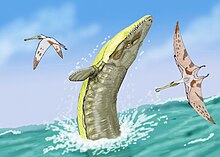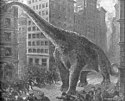Berrias
| System | Oddział | Piętro | Wiek (mln lat) | |
|---|---|---|---|---|
| Paleogen | Paleocen | Dan | młodsze | |
| Kreda | Górna | Mastrycht | 66,0–72,1 | |
| Kampan | 72,1–83,6 | |||
| Santon | 83,6–86,3 | |||
| Koniak | 86,3–89,8 | |||
| Turon | 89,8–93,9 | |||
| Cenoman | 93,9–100,5 | |||
| Dolna | Alb | 100,5–113,0 | ||
| Apt | 113,0–125,0 | |||
| Barrem | 125,0–129,4 | |||
| Hoteryw | 129,4–132,9 | |||
| Walanżyn | 132,9–139,8 | |||
| Berrias | 139,8–145,0 | |||
| Jura | Górna | Tyton | starsze | |
| Podział według IUGS, luty 2017 | ||||
Berrias (ang. Berriasian)
- w sensie geochronologicznym – najstarszy wiek wczesnej kredy, trwający około 5,2 milionów lat (od ok. 145,0 do ok. 139,8 mln lat temu). Berrias jest młodszy od tytonu a starszy od walanżynu.
- w sensie chronostratygraficznym – najniższe piętro dolnej kredy w eratemie mezozoicznym, wyższe od tytonu a niższe od walanżynu. Stratotyp dolnej granicy berriasu nie jest jeszcze zatwierdzony przez ICS. Dolna granica opiera się o najniższe wystąpienie amonita Berriasella jacobi.
Nazwa piętra (wieku) pochodzi od miejscowości Berrias-et-Casteljau w południowej Francji.
Fauna berriasu

Zwierzęta, których nazwy pogrubiono, są ograniczone do opisywanego piętra.
Ssaki
- Albionbaatar – wieloguzkowiec, Wielka Brytania
- Bolodon – wieloguzkowiec, Hiszpania
- Ecprepaulax – wieloguzkowiec, Portugalia
- Gerhardodon – wieloguzkowiec, Wielka Brytania
- Iberodon – wieloguzkowiec, Portugalia
Ptaki
- ? Gallornis – Francja
- ? Wyleyia – Wielka Brytania
Nieptasie teropody
- Dromeozauroid – celurozaur, Dania
- Nutetes – celurozaur, Wielka Brytania
- Embazaur – Kazachstan
Zauropody
- ? algoazaur – RPA
- ? galweozaur – turiazaur, Hiszpania
- ? turiazaur – turiazaur, Hiszpania
- ? ksenoposejdon – Wielka Brytania
- ? pelorozaur – brachiozaur, Wielka Brytania, Portugalia
Ankylozaury
- Hyleozaur – ankylozaur, Wielka Brytania
Stegozaury
Ornitopody
- ? Echinodon – heterodontozaur, Wielka Brytania
- ? kamptozaur – igunodon, Wielka Brytnia, Portugalia, USA
- Waldozaur – igunodon, Wielka Brytania, Niger
Pterozaury
- Eurolimnornis[1] – Rumunia
- Palaeocursornis[1] – Rumunia
- Plataleorhynchus – pterodaktyl, Wielka Brytania
Krokodylomorfy
- Dakosaurus andiniensis – Thalattosuchia, Wielka Brytania, Francja, Szwajcaria, Niemcy[2], Polska[3], Rosja[4], Argentyna[5], Meksyk[6]
- Geozaur – Thalattosuchia, Wielka Brytania, Francja, Szwajcaria, Niemcy[2], Argentyna[7], Kuba[8], Meksyk[9]
- Machimosaurus – Thalattosuchia, Austria, Wielka Brytania, Niemcy, Portugalia, Szwajcaria
- Steneosaurus – Thalattosuchia, Wielka Brytania, Francja, Niemcy, Szwajcaria, Maroko
- Goniopholis – Neosuchia, Tajlandia[10], Anglii, Niemcy, Portugalia[11], USA Morrison[12], Belgia
- Lisboasaurus – Hiszpania
Zobacz też
Przypisy
- ↑ a b Zaliczony do pterozaurów przez: Federico L. Agnolin i David Varricchio. Systematic reinterpretation of Piksi barbarulna Varricchio, 2002 from the Two Medicine Formation (Upper Cretaceous) of Western USA (Montana) as a pterosaur rather than a bird. „Geodiversitas”. 34 (4), s. 883–894, 2012. DOI: 10.5252/g2012n4a10 (ang.).
- ↑ a b Steel R. 1973. Crocodylia. Handbuch der Paläoherpetologie, Teil 16. Stuttgart: Gustav Fischer Verlag,116 pp.
- ↑ Radwańska U, Radwański A. 2003. The Jurassic crinoid genus Cyclocrinus D’Orbigny, 1850: still an enigma. Acta Geologica Polonica 53 (2003),(4): 301-320.
- ↑ Ochev VG. 1981. [Marine crocodiles in the Mesozoic of Povolzh'e] Priroda 1981: 103
- ↑ Vignaud P, Gasparini ZB. 1996. New Dakosaurus (Crocodylomorpha, Thalattosuchia) from the Upper Jurassic of Argentina. Comptes Rendus de l'Académie des Sciences, Paris, 2 322: 245-250
- ↑ Buchy M-C, Stinnesbeck W, Frey E, Gonzalez AHG. 2007. First occurrence of the genus Dakosaurus (Crocodyliformes, Thalattosuchia) in the Late Jurassic of Mexico. Bulletin de la Societe Geologique de France 178 (5): 391-397.
- ↑ Gasparini ZB, Dellapé D. 1976. Un nuevo cocodrilo marino (Thalattosuchia, Metriorhynchidae) de la Formación Vaca Muerta (Jurasico, Tithoniano) de la Provincia de Neuquén (República Argentina). Congreso Geológico Chileno 1: c1-c21.
- ↑ Gasparini ZB, Iturralde-Vinet M. 2001. Metriorhynchid crocodiles (Crocodyliformes) from the Oxfordian of Western cuba. Neues Jahrbuch für Geologie und Paläontologie, Monatshefte 9: 534–542.
- ↑ Frey, E., Buchy, M.-C., Stinnesbeck, W. & López-Oliva, J.G. 2002. Geosaurus vignaudi n. sp. (Crocodylia, Thalattosuchia), first evidence of metriorhynchid crocodilians in the Late Jurassic (Tithonian) of central-east Mexico (State of Puebla). Canadian Journal of Earth Sciences 39: 1467–1483.
- ↑ E. Buffetaut, R. Ingavat. Goniopholis phuwiangensis nov. sp., a new mesosuchian crocodile from the Mesozoic of North-eastern Thailand. „Geobios”. 16 (1), s. 79–91, 1983 (ang.).
- ↑ Daniela Schwarz. A New Species of Goniopholis from the Upper Jurassic of Portugal. „Palaeontology”. 45 (1), s. 185–208, 2003. DOI: 10.1111/1475-4983.00233 (ang.).
- ↑ Kent M. Hups, John Foster, Martin Lockley. A partial skeleton of Goniopholis from the Brushy Basin Member of the Morrison Formation. „Geological Society of America Abstracts with Programs”. 37 (6), 2005 (ang.).
Bibliografia
Media użyte na tej stronie
Autor: Creator: Dmitry Bogdanov, Licencja: CC BY 3.0
Life restoration of Dakosaurus maximus (breaching, center) and Gnathosaurus subulatus (flying).
Autor: Nobu Tamura (http://spinops.blogspot.com), Licencja: CC BY 3.0
Goniopholis simus, a crocodilian from the Early Cretaceous of Germany, pencil drawing




